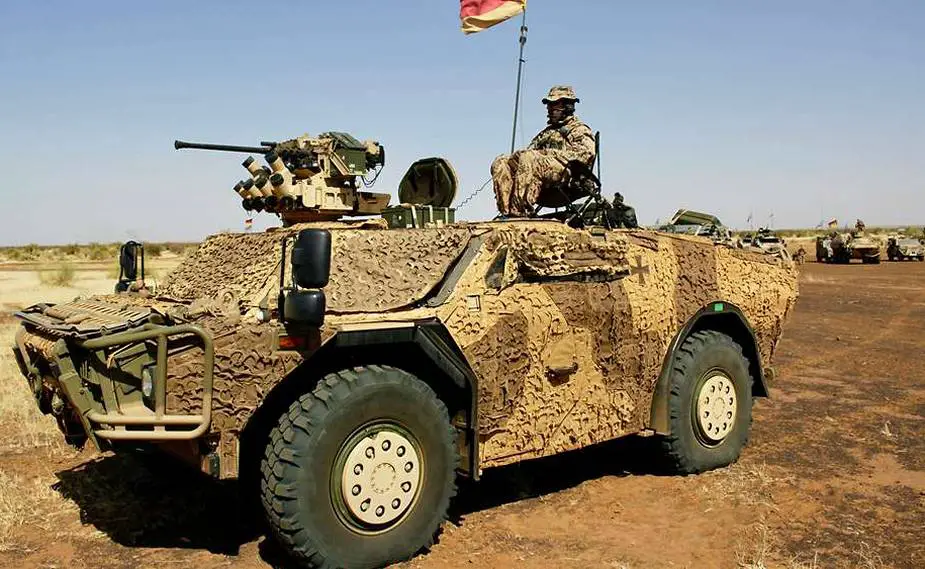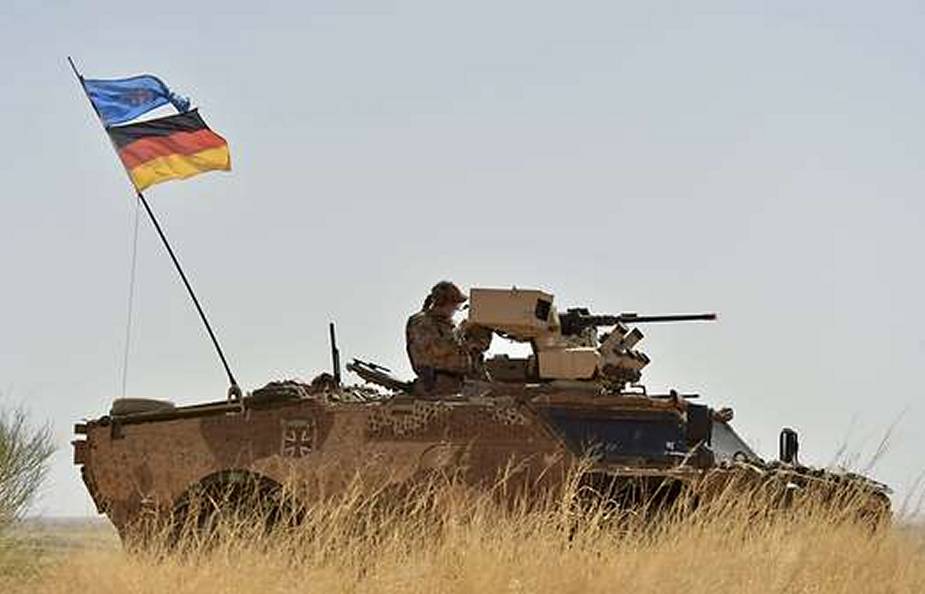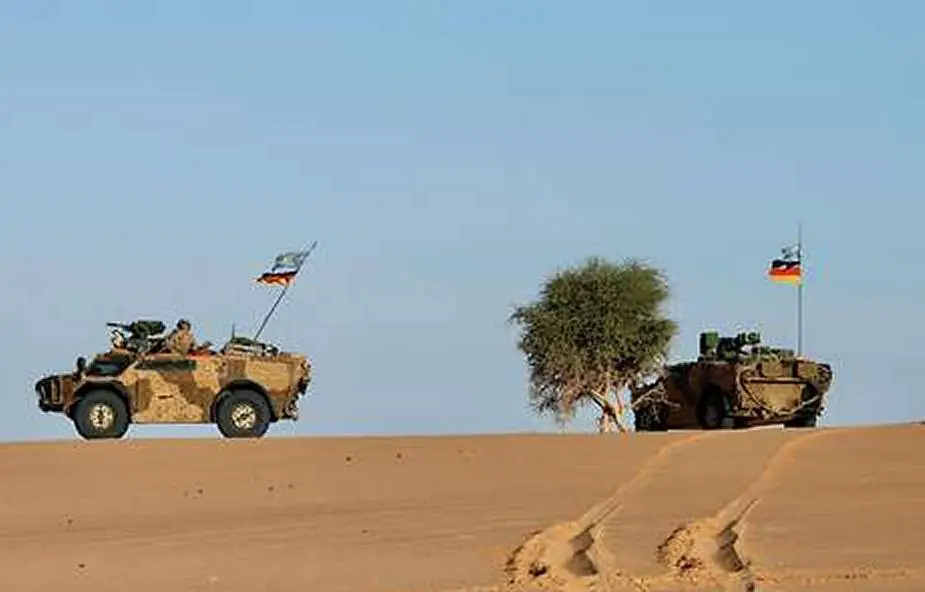Agile and small, Fennec is made for the steppes of Mali, Gerrit Hohmann and Georg Schiller report in the Bundeswehr website. The first goal assigned for a reconnaissance mission: a previously unknown checkpoint that was first observed by the Heron drone. Checkpoints are common in Mali. Its structure is typical for the region: a barbed-wire barrier has been laid across the street and prevents further travel. The only thing missing people are the “operators”.
Follow Army Recognition on Google News at this link

A German army Fennek posted at a checkpoint in Mali (Picture source: Bundeswehr/Axel H.)
Sometimes the checkpoints in Mali do not open until sunrise. The commander decides to drive closer to fulfill his mission: gather information. The people waiting have gone to sleep, sometimes between the vehicles, in the vehicles or simply on the roadside directly on the ground. This is not uncommon. The commander lets the Fennec (or Fennek) reconnaissance vehicle sneak up very close to the roadblock. The fennec is so quiet that people just snooze.
As soon as the job is complete, the driver engages the reverse gear. The commander observes with the help of a night vision device and sees how a head rises, drowsy - and not five meters away. He blinks in the direction of Fennek, which at this moment disappears into the darkness.
The spectrum of tasks of the reconnaissance troop also includes the exploration of possible bypasses and new routes that are not shown on any map. A new mission, ideal for the Fennek, which is extremely all-terrain and light despite good armor.

The Fennec is often used on elevated positions to continue observing (Picture source: Bundeswehr/Axel H.)
Finding possible passages - also for larger and heavier vehicles - in the steppe is only possible with experience and spontaneity in equal measure. The direction in which the goal lies is taken with a compass number. Then there are two options: either the scouts find a path or they evaluate the terrain to see if heavy vehicles can also get through. If this is not the case, the whole thing starts all over again.
The fennec roams effortlessly off-road, even when there are no trails. For the crew, exploring terrain means getting shaken up, just like in this moment. In the middle of the terrain, the driver recognizes a small ball of fur directly ahead. It is insanely fast on all four paws and has oversized ears, its main sensors. It stops a few meters away: a desert fox, a "real" fennec fox. The little one and the big one watch each other; a welcome breather for the soldiers. The ball of yarn then loses interest and nimbly trolls on its way. Also for the reconnaissance, it goes on in rough terrain. In search of new ways.
The following night, the gunner recognizes a pick-up in the distance, which seems deserted on a hill. In such a situation, Fennec's thermal imaging device comes into its own. The situation is "verified" in the weapon station. Under night vision and in total darkness, the Fennek stalks closer, since other vehicles can now be seen next to the pick-up. About ten people sleeping next to the vehicles are spotted by the Fennec's high-tech sensors. A person who is not sleeping, obviously assigned to be on guard duty, is reported to the commander from a great distance away.
The Fenneks quietly drive closer to get a better picture of the situation. Then comes the time when the crew realizes they need to be heard. But it still takes some time before the guards actually react to the vehicles. He sounds the alarm and wakes up his fellow combatants by shouting loudly. In a matter of seconds, ten sleeping people become ten armed fighters armed with handguns. The Fennecs are directly opposite them, with the advantage that the gunmen heard something but saw nothing.
Ready for a firefight, the commander orders them to retreat into the darkness. The background to the group found is not available. It is not possible to defuse the situation in any other way. Again within earshot of the sighted, another observation is made. Since no enemy is within reach or recognizable for the armed men, they go back to sleep after a short time. The commander in the Fennek sends a situation report to the command post and the reconnaissance mission continues.
New assignment: assist in securing a convoy. While the reconnaissance drone LUNA ensures surveillance and reconnaissance of the operational area from the air as a "flying eye", the Fenneks take over the security on the ground. All this with constant movement and relocation to other rooms, without any infrastructure. In this impassable terrain, the Bundeswehr tanker Mercedes Zetros has its difficulties despite the escort and security of the Fenneks. Filled to the brim with fuel, the combination is very heavy. Difficulties in getting ahead in the steppe are inevitable. It often gets stuck, sometimes so bad that it can no longer get out on his own.
The scout team attaches little Fennek to the large tanker truck with a tow bar. The driver switches on the differential locks in the vehicle. Now a hissing can be heard, the Fennek's integrated tire pressure control system lets some air out of the tires. Then little Fennek pulls the heavy, stuck tanker truck to the agreed meeting point. The refueling of the waiting troops of the LUNA airborne unmanned close reconnaissance equipment platoon will start immediately in order to be able to continue the job smoothly.
North of Gao is the next largest city of Bourem, also directly on the Niger River. The three fennecs are deployed there during a multi-sensor operation. This means that different reconnaissance units operate together in a given space. Different sensors achieve different reconnaissance results. If you put them together like the pieces of a jigsaw puzzle, you get a meaningful picture of the situation. Before heading to Bourem, it is announced that a large convoy of neutral forces will be passing through the theater of operations. Two reconnaissance squads are given the task of making contact and extensively documenting the convoy.
The reconnaissance drone Heron has localized the convoy, now it's up to the Fennecs to "bite their teeth". One scouting party positions itself north, the second south of the determined axis of movement. The convoy is already in the observation field when the Fennec arrives. The troop leader's Fennek has taken up position and reconnaissance and documentation begins immediately.
About 70 pick-ups, some with heavy machine guns, are spotted. Now comes the more difficult part of the job: staying in touch. The pickups are trying to lose the Fennec. Vain. With more than 80 km/h in the field, the reconnaissance officers got stuck and watched the convoy the entire route, up to the border of the operational area. Excellent reconnaissance results are achieved, which flow into the overall picture of the situation.

The scouts work in squads. Rarely does a fennec roam alone (Picture source: Bundeswehr/Axel H.)















